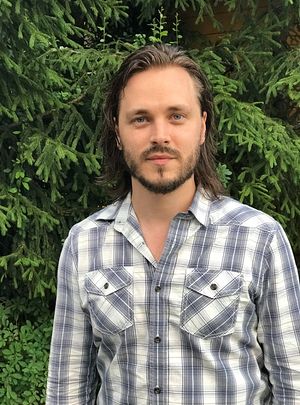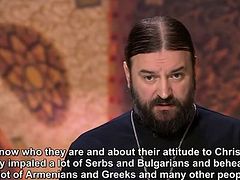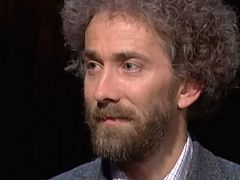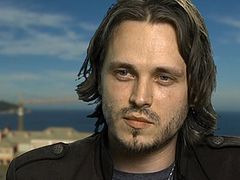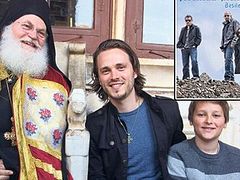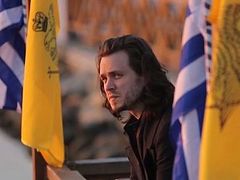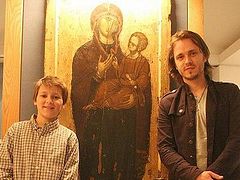Many of our readers will remember that several years ago the five-time Emmy Award winning Hollywood actor, singer, and musician Jonathan Jackson, together with his family, embraced Orthodoxy. According to his interviews, the first Orthodox priest to speak to him was Fr. John Strickland, who told him much about Holy Rus’. At that time, he firmly decided to pay a visit to Russia. And this year Jonathan and his family managed to visit Russia. He came with his spouse Elisa (in Orthodox Baptism – Elizabeth), son Caleb (Nicholas, fifteen), daughter Adora (Anastasia, thirteen), and son Titus (seven). I had the privilege of accompanying the Jacksons throughout their trip to Russia that took place from July 10 to 21 this year.
Having arrived to Moscow on July 10, they headed for Sergiev Posad. The very appearance of the hotel of the Holy Trinity-St. Sergius Lavra left a lasting impression on them. According to them, they had never been to hotels where icons were hanging in the lobby and all the rooms and walls were covered with frescoes. After a short rest the Jacksons went to the Lavra. The first thing they did was to visit the Holy Trinity Church where they prayed to St. Sergius of Radonezh and venerated his holy relics. The akathist to St. Sergius was being sung then, and after the service the priest anointed all of us with oil from the vigil lamp standing by the venerable father’s relics. Then we venerated other relics in the Lavra and prayed at the Vespers service in the Holy Dormition Church.
The next day, July 11, the pilgrims visited St. Clement’s Church in Moscow, where they had a good look at the paintings and venerated the icons with reverence. Jonathan remarked that he had read the writings of St. Clement of Rome when he had just converted to Orthodoxy. This was followed by a visit to the Tretyakov Gallery. First of all, they went to the Gallery’s church where they venerated the great Vladimir Icon of the Mother of God with awe. They have a copy of this icon in their house in America. They were particularly impressed by the old Russian icons dating back to the twelfth to seventeenth centuries. Among them, the Jacksons were especially delighted with the masterpieces by St. Andrei Rublev, notably the icon of the Holy Trinity. Comparing this gem of old Russian spirituality with that by Simon Ushakov, they preferred the former. I told them that the famous Russian writer Vladimir Soloukhin (1924-1997) was of the same opinion. The family also liked the works of many later painters, such as Surikov, Levitan, Repin, and Savrasov; some painters, like Vrubel, did not impress them much. They were inspired by the work of Mikhail Vasilyevich Nesterov in particular.
Jonathan had seen some reproductions of his paintings before but had not known the artist’s name. Now he has a clear and complete understanding of his work. As a man of art and author of the book, The Mystery of Art, dedicated to the development of a painter in the image of God, Jackson saw the embodiment of many of his ideas in Nesterov’s paintings. Elisa, an Italian by birth, observed that before converting to Orthodoxy she had taken pride in the work of her fellow-countrymen of the Renaissance, such as Michelangelo, and considered these paintings to be the highest form of art. But after her conversion to Orthodoxy her soul and consciousness transformed and she realized that Michelangelo’s paintings are quite a different type of art, far from being a result of a genuine spiritual life. Nesterov’s paintings truly won her heart. Elisa had never imagined that such works of art could ever exist, that a painter could transform people and nature in his spiritual world, nurtured by the spirit of God, in this way.
The next destination of their itinerary was the Convent of Sts. Martha and Mary in Moscow. Elisa was baptized in Orthodoxy with the name Elizabeth in honor of the New Martyr Grand Duchess Elizabeth Feodorovna. The couple knew that there was the convent of the sisters of mercy, founded by St. Elizabeth Romanov, somewhere in Moscow, without knowing its location, and during their trip to Russia they finally saw this masterpiece of architecture and center of spiritual life with their own eyes. They were deeply impressed by the convent’s church that was built in the style of old Russian churches, the monument to the Grand Duchess created by the sculptor Vyacheslav Klykov, and the church interior whose frescoes had been painted by Nesterov.
The Vigil service on the eve of the feast of the Holy Apostles Peter and Paul was celebrated at the church there. The guests attended the service and venerated the holy relics of the New Martyrs Elizabeth and Barbara. The weather was fickle that day, with bright sunshine and torrential rain often replacing one another. When it was time to go we realized that we wouldn’t be able to because of the heavy showers. While standing in the narthex, we decided to leave a donation at the church shop. Imagine our surprise when five minutes later the clouds dissipated, the sun began to shine again, and a rainbow appeared in the sky above the convent. Before leaving the convent, little Titus fell down in front of the monument to St. Elizabeth Feodorovna and prayed for a long time with his angelic prayer of a child. After the convent, our pilgrims managed to visit the Church of St. Nicholas in Pyzhy, which is located nearby, where they venerated the wonder-working icon of the Tsar-Martyr Nicholas II and listened to a sermon delivered by its rector, Archpriest Alexander Shargunov, following the Vigil.
The following day began with a visit to the Moscow Convent of the Protection of the Mother of God and the veneration of the holy relics of the Blessed Matrona of Moscow. There was a large line to the saint’s relics, with a two-hour wait. There is a huge time difference between Moscow and America, so the first days were difficult for our guests, especially the children. After standing in line for half an hour, we decided to go up to guards to ask them to at least allow the mother with children to pass the line to the relics. We explained the situation to them, and the kind guards allowed us all to go up to the relics. Thus, Blessed Matrona herself helped us.
Then we visited Christ the Savior Cathedral, venerated the relics of the Holy Hierarch Philaret (Drozdov) of Moscow along with icons that are kept there, and admired the splendid interior and exterior of this wonderful church-monument. Then I showed our guests Red Square, the State Historical Museum, St. Basil’s Cathedral, the Monument to Minin and Pozharsky, and the Lobnoye Mesto [literally: “the Forehead Place”; a sixteenth-century circular stone platform in Red Square—trans.] and told them a little about the history of these objects. Then we took a night train from Moscow to St. Petersburg.
The work of Fyodor Mikhailovich Dostoevsky played an important role in Jonathan’s development as a person and a Christian. He read the novel The Idiot at the age of fourteen and has been a fan of Dostoevsky ever since. The great writer contributed to Jonathan’s conversion to Orthodoxy too. One of the aims of the Jacksons’ visit to Russia was visiting the memorial sites associated with Fyodor Dostoevsky. We had also prearranged a meeting with some of the Russian writer’s descendants. In the morning of July 13, the Jacksons met with two members of the Dostoevsky family at the St. Alexander Nevsky Lavra, namely Dmitry Andreevich Dostoevsky, the novelist’s great-grandson, and his son Alexei, the novelist’s great-great-grandson. First they visited the Holy Trinity Cathedral and venerated the relics of the Right-Believing Prince Alexander Nevsky there. Next they proceeded to the Nikolskoye Cemetery where they prayed at the grave of the ever-memorable Metropolitan John (Snychev, 1927-1995) of St. Petersburg. At the necropolis they visited the grave of Fyodor Dostoevsky and prayed for the repose of his soul. Dmitry Andreevich Dostoevsky told the guests much about his illustrious great-grandfather as well as his great-grandmother, Anna Grigorievna Dostoevskaya, who in her young days lived next to the Lavra (her house still exists). Then they walked along the necropolis and saw the graves of the composers Pyotr Tchaikovsky, Nikolai Rimsky-Korsakov, Mikhail Glinka, and many other Russian cultural figures. After that, we all went to the Dostoevsky Museum. There Dmitry Andreevich told us much more about the life of Fyodor Dostoevsky, supplementing the official biography with family traditions. It was especially important for Jonathan and his whole family to see with their own eyes the interior of the museum and to feel the spirit of the epoch in which the author lived. This all made a strong impression on our guests.
Next we walked around the city center and told our guests about the main churches, palaces and other sights of St. Petersburg. The pilgrims visited the Cathedral of the Kazan Icon of the Holy Theotokos where they venerated the wonderworking Kazan Icon and saw the grave of General Field Marshal Mikhail Kutuzov. This was followed by an hour’s tour along the rivers and canals of “the northern capital” of Russia and the guests were very pleased. The day was concluded with another meeting with the Dostoevsky family. At Dmitry Andreevich’s invitation, we went to his house, listened to interesting stories about the great writer’s present and past descendants, familiarized ourselves with the family treasures, and had aromatic tea with pies. Jonathan was touched by the Russian hospitality and the historicity of this unique moment. Having received parting gifts from the Dostoevsky family, we warmly said goodbye to them and promised to pay them another visit next time.
July 14 began with a visit to the Peterhof Palace and Park (now in the town of Petrodvorets; a former royal countryside residence—trans.]. We recounted the history of this wonderful suburb of St. Petersburg and its fountains and how it suffered during the Nazi occupation. We enjoyed a stroll in the park, near the fountains, and admired the beauty of the sea and the view of Kronstadt. Then we headed to Smolenskoye Cemetery where we venerated the holy relics of the Blessed Xenia of St. Petersburg and prayed at her grave inside the chapel. Then we went to St. John’s Convent [in honor of St. John of Rila, founded by St. John of Kronstadt—trans.] and prayed in front of the relics of St. John of Kronstadt.
After a short rest, we took an overnight flight to Ekaterinburg. We landed early in the morning of July 15. After a brief respite we made a visit to the Church-on-the-Blood in honor of the New Martyrs and Confessors of the Russian Church, built on the site of the Ipatiev House where the holy Royal Martyrs had been murdered 100 years ago. We looked around the church and venerated the icons. We offered up special petitions to the Royal Martyrs in the lower church where the Imperial Family had been executed. The visit to this church made a very strong impression upon the pilgrims.
Before leaving for Russia, the Jacksons had read the correspondence of the Tsar and the Tsarina, were inspired by their personalities, and came to love the whole of the Royal Family. Additionally, they liked the song by the well-known patriotic Russian Orthodox singer Zhanna Bichevskaya dedicated to the Royal Martyrs, the refrain of which consists of their names. Jonathan and Elisa would often hum its tune thereafter. It should be said that on the threshold of the main event—the midnight Liturgy at the Church-on-the-Blood—the preparation for it was in full swing, and many priests began to hear confessions of the faithful. Thus, that evening all of us managed to confess and receive a blessing for taking Communion the next day. Next we set off for the Monastery of the Holy Royal Passion-Bearers at the Ganina Yama pit, a place of both great sorrow and spiritual triumph. We attended Vespers there and venerated the cross at the pit itself. We saw the pilgrims, many of whom had been walking from all over the country and even abroad on the eve of the memorable event. Our guests were filled with spiritual joy and felt peace and quiet there—something that many of us intuitively crave for but cannot find amid the hustle and bustle of modern life.
The next day, July 16, we went to the Church-on-the-Blood again, when the Small Vespers with the Akathist to the Holy Royal Martyrs was being served there. After the Akathist, we venerated the icons, notably the “Three-Handed” Icon of the Theotokos before which the Royal Martyrs had prayed while in confinement. Our guests had learned many phrases in Russian and Church Slavonic by heart during their stay, so when I was reading the prayers before Holy Communion Jonathan participated by uttering exclamations like “Lord have mercy” and some others. After a short break at ten in the evening, we again headed for the Church-on-the-Blood where His Holiness Patriarch Kirill presided over the Divine Liturgy at midnight. This was the culmination of the festal events of those days for all of us. We all managed to take Holy Communion at that Liturgy by the grace of God.
 The Jacksons beside the Church-on-the-Blood in Yekaterinburg during the midnight Liturgy on July 17, 2018
The Jacksons beside the Church-on-the-Blood in Yekaterinburg during the midnight Liturgy on July 17, 2018 Our pilgrims staunchly withstood all the hardships of the hours-long services and remained peppy, including the seven-year-old Titus whom I carried to Holy Communion. After the Liturgy we joined the procession that was walking towards the Ganina Yama pit for a short while and then headed for the hotel because our pilgrimage across Holy Russia was to continue the following morning. According to our guests, they will never forget this event.
The next day, July 17, we flew from Ekaterinburg to Nizhny Novgorod via Moscow. Our guests liked this ancient city and were especially fascinated by the breathtaking views of the Oka River from the hotel. The next day, July 18, was the centenary of the killing of Sts. Elizabeth, Barbara and all the martyrs of Alapaevsk. In the morning we greeted Elisa on her name day and set off for Diveevo by car. We made a stop en route in Arzamas to look around the churches on Cathedral Square. Upon arriving to Diveevo we first went to the parish church in honor of St. Elizabeth the New Martyr. Although the festal Liturgy was over, we did venerate the icons, two of which (those of Grand Duchess Elizabeth and Grand Prince Vladimir with Tsar-Martyr Nicholas II) had started streaming myrrh during the celebrations. Another miracle was waiting for us at that church. It turned out that in addition to the upper Church of St. Elizabeth the New Martyr (Elisa’s patron-saint) there was also the lower Church of St. John the Divine, who is Jonathan’s patron saint. The lower church also has icons of St. Nicholas (in whose honor Caleb was baptized) and the Great Martyr Anastasia of Sirmium, the “Deliverer from Potions” (Adora’s patron saint). Thus, all but Titus (whose name is very rare in Russia) found their patron saints in this church! It was an unforgettable experience for all of them.
Then we visited the three holy springs in Diveevo and finally reached the convent. First we went inside the Church of the Kazan Icon of the Theotokos just outside the convent’s gates where we venerated the relics of the saints of Diveevo, recalled the history of the monastery and some of the prophecies of St. Seraphim of Sarov. Then we entered the convent, visited the Holy Trinity Church where we venerated the relics of St. Seraphim and saw some of his personal belongings that are kept at the church as well. Next we venerated the icons, including the “Tenderness” Icon of the Mother of God, then went to the Transfiguration Cathedral, and prayerfully walked along the Holy Canal of the Theotokos. Then we sat to rest for a bit. Elisa remarked that while visiting such holy places you forget all the hardships and problems of your life, and feel peace of mind, quiet and spiritual delight. Then we drove to the village of Tsyganovka, to St. Seraphim’s spring and dipped into its icy cold water. This also filled us with joy and invigorated us. Late in the evening we returned to Nizhny Novgorod.
Early the next morning, July 19, we flew from Nizhny Novgorod to Mineralnie Vodi [in Stavropol Krai in southern Russia—Trans.] via Moscow. There we visited the Church of the Protection of the Mother of God where we venerated the relics of the Blessed Theodosius of the Caucasus (1841-1948). After that we travelled to the city of Pyatigorsk and climbed to the top of Mashuk Mountain, at the foot of which the great Russian poet Mikhail Lermontov had been tragically killed in a duel. We also visited the marvelous Church of the Three Holy Hierarchs. Since Jonathan is a frequent visitor to Holy Mount Athos he was pleasantly surprised to find a large number of icons and other relics brought by local priests from Athonite monasteries to this church. Architecturally, the Church of the Three Holy Hierarchs combines the Byzantine and old Russian traditions.
The next day, July 20, we traveled to the village of Praskoveya and the town of Budyonnovsk [both in the Stavropol territory—Trans.], the original name of which was Svyatoy Krest (meaning “Holy Cross”). I recounted the history of these places to Jonathan and his family and reminded them of the tragic events of 1995 [when armed Chechen militants raided the town of Budyonnovsk and took hostages at a local hospital, killing over 100 people—Trans.], which found deep sympathy in their kind hearts. We visited the Church of St. Alexander Nevsky there along with the Church of the Kazan Icon of the Mother of God, where we venerated an icon of the martyred Prince Michael of Tver [the 700th anniversary of his martyrdom is celebrated this year—Trans.]. After a short rest we had a night flight to Moscow. I saw my dear guests off to the airport and they left for America. We warmly bid farewell, agreeing that they would certainly come back to Russia often.
In conclusion, it should be said that the trip to Russia, the pilgrimages to its holy shrines, and meetings with many Russian people left an indelible impression on the Jacksons. According to them, now they have seen Holy Russia, which will remain in their hearts forever. After this big pilgrimage they became very different people, something transformed in their hearts, and they feel they will always be drawn to Russia. This tour has also influenced Jonathan’s creative work, particularly his music activity. Russian spirituality has become a great source of inspiration for him. All the Russian people who had the honor of speaking with this charming American family feel a strong brotherly love towards them and are looking forward to meeting them again.









